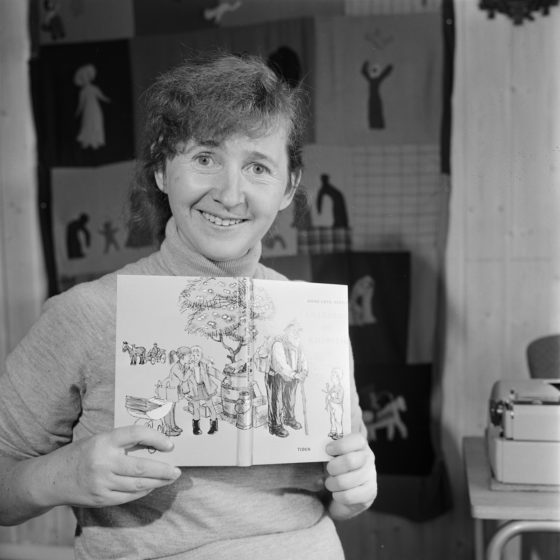
In numerous articles, exhibitions and a new biography, Vestly is hailed as a pioneer and innovator of literature for the youngest readers, challenging Norway’s conventional ways with radical ideas. Vestly had the nerve, for example, to let her first fictional child character Ole Aleksander Filibom-bom-bom learn that babies are actually born from their mothers, not delivered by a stork or a miracle.
That was in 1954, and Vestly was accused of spreading “undesirable sex education for minors.” More controversy followed in her stories that featured working mothers and stay-at-home dads, along with other challenges to conventional family patterns.
‘Enormous respect for children’
Norwegian children’s literature would look very different without Anne-Cath Vestly, according to Agnes-Margrethe Bjorvand, author of a new biography on Vestly.
“She was instrumental in bringing children’s perspective into literature,” Bjorvand told Dagsavisen. “When she started writing in the 1950s, the general attitude was that children were to be seen but not heard. Vestly’s approach to children is very generous. Anne-Cath Vestly had an enormous respect for children, as large as for grownups.”
Vestly, who died in 2008, wrote almost 50 children’s books, most of them set in the decades of reconstruction and dramatic economic change that followed World War II. Many of them were illustrated by her husband Johan. The couple had two sons.

The main settings for Vestly’s tales were the unglamorous everyday communities of the time, some featuring rural poverty and others the darker realities of modern-day high-rise suburbs. Moving between these contrasting worlds, and their subsequent human encounters, is a key plot-driver. The most important players in all these stories are children, like city boy Ole Aleksander and Lillebror, whose closest friend in his remote rural home area is a human-shaped tree root he calls Knerten and engages in wide-ranging conversations.
Fantasy is never far away in Vestly’s early work. It has a touch of what has sometimes been called “magic realism,” stuff that grownups may find silly but that children can easily grasp.
Vestly initially presented her stories, long before they became books, by reading them on a daily radio program on state broadcaster NRK called Barnetimen for de minste (Children’s Hour for the Youngest), one of very few broadcast offerings to children in the early 1950s. Vestly was not looking for a book publisher, according to one Wikipedia article. The publishing house Tiden Norsk Forlag, owned by the Labour Party, found her. Studies of Vestly’s style have in turn found that its origins in radio-reading shine through in her books. They’re typically composed of finished episodes of roughly the same length, but with a context and continuation designed to bring young listeners back the next day.
Grownups seem unimportant in Vestly’s universe, with one notable exception: Mormor (mother’s mother). She’s a fun and ever-supportive grandmother at the center of a flock of eight brothers and sisters, their parents presumably busy working to make ends meet. Vestly wrote seven books about this particular cast of characters, known as Mormor og de åtte ungene. Vestly serialized most of her stories, with five books about Ole Aleksander, eight about Lillebror and his wooden friend Knerten, seven about a suburban girl called Aurora and another seven about her neighbor Guro. Vestly also developed other characters.
Acting career as well
Sometimes her worlds collided, with kid characters from early stories returning as adults later on, or mormor popping up in unexpected settings. Towards the end, almost everyone from the books ends up living in Tirilltoppen, a fictional suburb resembling the Bøler area of Oslo where Vestly spent most of her adult life. In this respect, Vestly’s recycling of people and plots resembles the state of current superhero universes, suggests Dagsavisen columnist Aslak Borgersrud. On the other hand, “there is a different and calmer tempo in Anne-Cath Vestly’s books than in many other children’s culture products,” her biographer Anne-Margrethe Bjorvand told Dagsavisen.
Vestly also created TV shows and movies throughout her career, sometimes with herself in key roles. In one such show she’s the character Kanutten visiting from a fantasy world, ignorant about the ways of humans on earth but possessing a magic force that makes food fall from the sky. In the Kanutten shows, she worked with another icon of post-war entertainment for children, the singer-songwriter, actor and Barnetimen for de minste host Alf Prøysen.
Many of Vestly’s books have been translated and published in more than a dozen countries, including the former Soviet Union. Some have also been adapted for foreign audiences, with localized names and few traces of the Norwegian setting. She won a number of Norwegian awards, and in 1992, she was knighted by King Harald V.
Vestly suffered from dementia late in life and struggled to complete her final works. After her death in 2008, Aftenposten wrote in an obituary: “She created new role models in a time of change by writing about fathers doing domestic chores and mothers working outside of home, and perhaps she made life easier for children who were not growing up in a mainstream family.”
newsinenglish.no/Morten Møst

